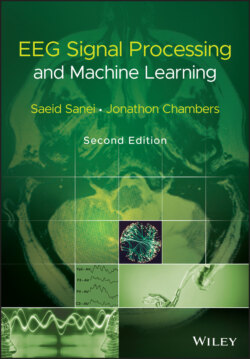Читать книгу EEG Signal Processing and Machine Learning - Saeid Sanei - Страница 16
1.4 Action Potentials
ОглавлениеAP is actually the information transmitted by a nerve. These potentials are caused by an exchange of ions across the neuron membrane and an AP is a temporary change in the membrane potential that is transmitted along the axon. It is usually initiated in the cell body and normally travels in one direction. The membrane potential depolarizes (becomes more positive) producing a spike. After the peak of the spike the membrane repolarizes (becomes more negative). The potential becomes more negative than the resting potential and then returns to normal. The APs of most nerves last between 5 and 10 ms. Figure 1.4 shows an example of an AP.
Figure 1.4 An example of an AP.
The conduction velocity of APs lies between 1 and 100 m s−1. APs are initiated by many different types of stimuli; sensory nerves respond to many types of stimuli, such as: chemical, light, electricity, pressure, touch, and stretching. Conversely, the nerves within the CNS (brain and spinal cord) are mostly stimulated by chemical activity at synapses.
A stimulus must be above a threshold level to set off an AP. Very weak stimuli cause a small local electrical disturbance, but do not produce a transmitted AP. As soon as the stimulus strength goes above the threshold, an AP appears and travels down the nerve.
The spike of the AP is mainly caused by opening of Na (sodium) channels. The Na pump produces gradients of both Na and K (potassium) ions, both are used to produce the AP; Na is high outside the cell and low inside. Excitable cells have special Na and K channels with gates that open and close in response to the membrane voltage (voltage‐gated channels). Opening the gates of Na channels allows Na to rush into the cell, carrying a +ve charge. This makes the membrane potential positive (depolarization), producing the spike. Figure 1.5 shows the stages of the process during evolution of an AP for a giant squid.
For a human being the amplitude of the AP ranges between approximately −60 to 10 mV. During this process [23]:
1 When the dendrites of a nerve cell receive the stimulus the Na+ channels will open.
2 If the opening is sufficient to drive the interior potential from −70 mV up to −55 mV, the process continues.
3 As soon as the action threshold is reached, additional Na+ channels (sometimes called voltage‐gated channels) open. The Na+ influx drives the interior of the cell membrane up to about +30 mV. The process to this point is called depolarization.
4 Then Na+ channels close and the K+ channels open. Since the K+ channels are much slower to open, the depolarization has time to be completed. Having both Na+ and K+ channels open at the same time would drive the system towards neutrality and prevent the creation of the AP.Figure 1.5 Changing the membrane potential for a giant squid by closing the Na channels and opening K channels.(Source: adapted from Ka Xiong Charand [23].)
5 Having the K+ channels open, the membrane begins to repolarize back towards its rest potential.
6 The repolarization typically overshoots the rest potential to a level of approximately −90 mV. This is called hyperpolarization, and would seem to be counterproductive, but it is actually important in the transmission of information. Hyperpolarization prevents the neuron from receiving another stimulus during this time, or at least raises the threshold for any new stimulus. Part of the importance of hyperpolarization is in preventing any stimulus already sent up an axon from triggering another AP in the opposite direction. In other words, hyperpolarization assures that the signal is proceeding in one direction.
After hyperpolarization, the Na+/K+ pumps eventually bring the membrane back to its resting state of −70 mV.
The nerve requires approximately two milliseconds before another stimulus is presented. During this time no AP can be generated. This is called the refractory period. The generation of EEG signals is next described.
